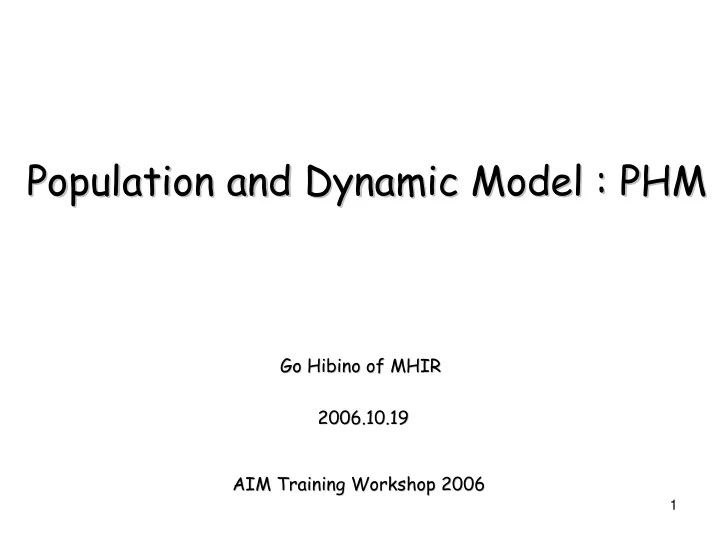

Population and Dynamic Model : PHM Population and Dynamic Model : PHM Go Hibino of MHIR Go Hibino of MHIR 2006.10.19 2006.10.19 AIM Training Workshop 2006 AIM Training Workshop 2006 1
1. Background • Population is the most important factor for future GHG emissions. • Japan’s population decreases from 2006. • Distribution of population has much effect on structure of energy system in transportation and residential sectors. • National Institute estimate future national population by 2100, but future number of national household and province-wise population by 2025/2030. 2
2. Input/Output of PHM <National> <Province-wise> 1) Population in base year [Sex, Age] 1) Population in base year [Sex, Age] 2) Birth rate [Sex, Age, Year] 2) Birth rate [Sex, Age, Year] 3) Net migration [Sex, Age, Year] 3) Int. migration [Sex, Age, Year] Input ----- ------- 4) Headship rate [Sex, Age, Family, Year] 4) Headship rate [Sex, Age, Family, Year] ----- 5) Climate Div. share [Climate, Year] 6) Landuse Cls. share [Landuse, Year] Population and Households Model National Province-wise Output • Population [Sex, Age, Year] Passenger Landuse Cls.-wise Trn. Model National • Household [Family, Year] Province-wise Buildings Climate Div.-wise 3 Dyn. Model
2. Input/Output of PHM <Source of Input> Input of PHM Source (Japan) 1) Population in 2000 Statistics by (National, Province-wise) Ministry of Internal Affairs 2) Birth rate National Institute of Population and Social Security Research 3) Migration 4) Headship rate (National, Province-wise) 5) Climate Div. Share 6) Landuse Cls. Share 4
3. Logic of PHM < Cohort Component Method > 80 60 40 20 T Migration 0 Birth rate 80 60 40 Survivorship 20 T+1 0 5 Sex rate
Populatin(Age, Sex, Year) = Population(Age, Sex, Year-1) × Survivor rate(Age~Age+1, Sex, Year) × 1+Net Migration rate(Age~Age+1, Sex, Year) Population(“1”, Sex, Year-1) = Σ { Population(Age, “Female”, Year-1) × Birth rate(Age, Sex, Year)} × Survivor rate(“Birth~1”, Sex, Year) × 1+Net Migration rate(“Birth~1”, Sex, Year) Number of Households (Family, Year) = Σ {Population(Age, Sex, Year) × Headship rate(Family, Age, Sex, Year)} 6
3. Logic of PHM < Flow of PHM > Province-wise Total population Population Adjustment (Period T-1) (Period T-1) Province-wise [Sex, Age] Survival rate [Sex, Age] survival rate [Sex, Age] Consistency [Sex, Age] Adjustment Fertility rate Province-wise [Age] fertility rate Consistency [Age] International Adjustment Net-migration (Domestic Prs.) Province-wise net-migration Province-wise Total population Consistency [Sex, Age] International Population (Period T) net-migration (Period T) [Sex, Age] (Outsider Prs.) Province-wise [Sex, Age] headship rate [Sex, Age, Family] Province-wise climatic division Headship rate share [Sex, Age, Family] Province-wise landuse Cls. share Total number of Landuse Cls.-wise Climate zone.-wise Province-wise Household population population household (Period T) and households and households : Data flow (Period T) [Family-wise] (Period T) (Period T) : Exogenous variable [Age, Family] 7 [Sex, Age, Family] [Sex, Age, Family] : Endogenous variable
4. Output of PHM 140 100% 90% 120 80% 80- 80- 100 Population (Thousand) 70% 60-79 60-79 60% 80 40-59 Population 40-59 50% 20-39 60 20-39 40% 0-19 0-19 30% 40 20% 20 10% 0 0% 2000 2010 2020 2030 2040 2050 2000 2010 2020 2030 2040 2050 Japan’s future population 8
4. Output of PHM B scenario A scenario 100% Chubu, Shikoku, Kyushu その他中部・四国・九州 Kinki その他近畿 80% Chubu その他中部 Kanto その他関東 60% Hokkaido, Tohoku 北海道・東北(除く宮城) Miyagi, Hiroshima, 宮城・広島・福岡 Fukuoka 40% Osaka, Kyoto, Hyogo 大阪・京都・兵庫 Aichi 愛知県 20% Tokyo 東京 Chiba, Saitama, Kanagawa 千葉・埼玉・神奈川 0% 1920 1930 1940 1950 1960 1970 1980 1990 2000 2010 2020 2030 2040 2050 1920 1930 1940 1950 1960 1970 1980 1990 2000 2010 2020 2030 2040 2050 9
4. Output of PHM 100% 80% Others Parent- 60% Children One-Person 40% Couple-Only 20% Couple- Children 0% 2000 2005 2010 2015 2020 2025 2030 2035 2040 2045 2050 Japan’s future number of household 10
Recommend
More recommend